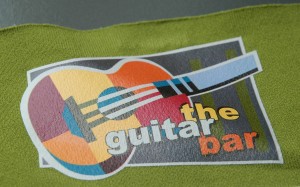Heat Printing
February 1, 2014
Heat Printing
Overview
Heat or transfer printing is a decorating process which uses heat-applied transfers and a heat press to transfer designs and images onto garments. There is a wide variety of heat printing processes, such as transfer papers, plastisol/screen printed transfers, dye sublimation, and print/cut applications. There are a variety of methods used to produce heat transfers.The ClassB heat printing method
The artworkArtwork specifications for heat printing are similar to Digital printing as both methods allow for a higher resolution image. The artwork is prepared in as many colors as required and may contain photo-realistic images.The transfer materialWe use a 55 micron thick polyurethane transfer material which is lab certified with the highest rating for color fastness, rebound, and carries at 50 washability rating. It uses a patented adhesive for a superior bond. |
The inkWe use solvent based ink for a high quality print. There are four different ink colors – cyan, magenta, yellow and black. Those four colors combine to make the entire range of the color palette.The printing processPrinting is done with a digital printer/plotter that first prints the image on the transfer material and then cuts the border for the transfer. It is a very precise process. Then the transfer is applied to the garment using a heat press to apply the proper pressure, temperature and time to properly seal the transfer to the garment. Once cooled, the garment is inspected and packed for shipping. |
Other Methods
While all heat printing uses a heat seal press, there are a large variety of transfer preparation processes.
Laser/Inkjet transfer paperThis is the simplest form of the heat printing processes. Special paper is fed through a laser printer or ink jet printer then trimmed by hand and applied to the garment. It is inexpensive and very quick. Unfortunately, it does not work well on dark fabrics and does not wash well.Sublimation TransferIn sublimation transfers, a special ink is used that, when heated, turns to a gas and dyes the fabric. Dye sublimation provides sharp, colorful images with a soft feel, allowing fabric to stay light and breathable. However, sublimation is limited to use on white or light-colored materials. Because the garment must be made of or coated with polyester, it is not an ideal method for use on garments. |
Plastisol TransferThis is a process where standard screen printing techniques are used to apply the ink to a paper carrier. The ink is then partially cured and then applied using a heat press to finish the cure. It provides much of the benefits of screen printing without the equipment required to cure an entire garment. However, plastisol transfers are fragile and can be easily damaged by heat, light or abrasion. |
How do I use a purchase order to pay for my order?
September 18, 2013
Qualifying organizations can use a purchase order with their initial order and receive NET 10 terms. Other organizations may need to first submit a credit application or may need to pay using a check or credit card. Read this entire article to determine which policy applies to you.
If you are a…
If you meet the requirements above, you can choose from 3 easy ways to submit your purchase order:
- BSA Council
- Public School
- Government Agency (Municipal, County, State or Federal)
- Bank
- National Brand Car Dealership
- Hospital
Then you can receive NET 10 terms on your initial order, if:
- You provide a written copy of your purchase order that includes the customers name and shipping address. (An “intent to purchase” on letterhead is also satisfactory.)
- Product is shipped to the organization’s address and not a home address.
If you are a…
- Private or Religious School
- Business (other than those listed above)
- Faith-based organization
Then you can receive NET 10 terms on your second order, if:
- You prepay for your first order with a check or credit card.
- You submit a credit application before submitting your second order and we approve that application.
- Shipment of all orders are to the organization’s address as listed on the credit application.
- Email a copy to your customer representatives
- Fax to 888-744-1409
- Mail a physical copy (this will delay your order). Contact Us | ClassB®
The hem on my shirts came undone, can you help?
July 2, 2013
Here at ClassB, we always strive to give our customers top-quality custom t-shirts along with the best possible customer service. In fact, we go above and beyond to exercise exceptional quality control procedures several times throughout the creation and production of your t-shirts. Unfortunately, there are times when even the most stringent quality control standards cannot prevent particular issues from occurring.
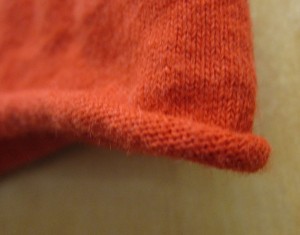
Over the past year, a very small number of our customers have reported a problem that occurred with a few of the t-shirts in their order. The problem is the bottom hem comes undone after the first washing. This happens because the lock stitch was not sewn correctly in the t-shirt manufacturing process.
We informed Gildan right away and they are aware of the issue. They traced it back to the machine that was causing the problem and repaired it. Gildan said that this type of problem rarely happens and only a small percentage of affected shirts made it past their inspectors. Less than 1 in 1,000 shirts were affected by this problem but we’re still taking it seriously.
If this happens to any of the shirts in your order, we will replace the shirt or refund the cost of the garment in full.
This can happen to any stitch on your t-shirt, like on the sleeve or collar. These are extremely rare but we will deal with them in the same way, by fixing it for you. For the few customers who have experienced this problem, we sincerely apologize.
Your satisfaction is our number one priority. If you happen to receive one of these t-shirts, please let us know ASAP so we can make things right.

Over the past year, a very small number of our customers have reported a problem that occurred with a few of the t-shirts in their order. The problem is the bottom hem comes undone after the first washing. This happens because the lock stitch was not sewn correctly in the t-shirt manufacturing process.
We informed Gildan right away and they are aware of the issue. They traced it back to the machine that was causing the problem and repaired it. Gildan said that this type of problem rarely happens and only a small percentage of affected shirts made it past their inspectors. Less than 1 in 1,000 shirts were affected by this problem but we’re still taking it seriously.
If this happens to any of the shirts in your order, we will replace the shirt or refund the cost of the garment in full.
This can happen to any stitch on your t-shirt, like on the sleeve or collar. These are extremely rare but we will deal with them in the same way, by fixing it for you. For the few customers who have experienced this problem, we sincerely apologize.
Your satisfaction is our number one priority. If you happen to receive one of these t-shirts, please let us know ASAP so we can make things right.
The Top 4 Questions You Should Ask Your Screen Printing Company
May 18, 2012
I often hear about customers that are considering buying from a local vendor because that vendor will be able to manufacture t-shirts for a lower cost without following the laws affecting that purchase. These vendors often try to include their clients by convincing them that it’s a perfectly ok thing to do because they won’t be caught. The worst of these are the vendors that have no knowledge of the law. We’ve been in this industry for about 30 years and unfortunately many of these vendors are disreputable. They usually work around regulations as a form of cutting expenses.
Based on my experience, I believe that once a company is willing to skirt a few laws, they are most likely breaking as many as they can without getting caught. If you do chose to go with a local vendor, please ask the following 4 questions:
Yes, we find this frustrating. I have heard many callous comments from other screen printers about needing to provide safe products. The big companies usually understand, but there are so many small local operators that feel that if the customer wants a low price that using inexpensive but dangerous chemicals is ok. Grrrrr!
Based on my experience, I believe that once a company is willing to skirt a few laws, they are most likely breaking as many as they can without getting caught. If you do chose to go with a local vendor, please ask the following 4 questions:
Do you have systems in place to handle and dispose of screen printing chemicals properly?
You would think no one would knowingly break the law when it comes to health and safety. There are many laws and regulations covering these areas. Proper handling and disposal of chemicals is one of the most important concerns for screen printers. There are laws in place to protect worker safety and waste water systems. Many of the chemicals that are available in our industry are dangerous to people and ecosystems. As a vendor, I know it costs a lot of money to ensure that our chemicals are handled safely and responsibly.Have you done the testing and labeling required by CPSIA on all your products and inks?
Product testing is crucial to YOU and your group’s personal safety. It’s the law that companies do some basic testing on their t-shirts and inks. The tests that are required are specified in the federal law CPSIA. Dangerous chemicals like lead and phthalates are illegal, but unfortunately these chemicals are still found in screenprinting inks across the country. Companies demonstrate their compliance and testing with a special label. All products must have this label if they could be worn by a child. Most of the dangerous chemicals that companies use are harmful to kids and adults are mostly unaffected. Therefore, labeling is optional on adult products. If a local company offers to not label the product according to the law, you can bet they are protecting themselves and not you. They are skipping the testing in order to conceal something or to avoid the costs of testing, in the hopes that when something goes wrong, no one can trace it back to them.Yes, we find this frustrating. I have heard many callous comments from other screen printers about needing to provide safe products. The big companies usually understand, but there are so many small local operators that feel that if the customer wants a low price that using inexpensive but dangerous chemicals is ok. Grrrrr!
What are your policies regarding tax exempt status?
I don’t know every state’s tax laws, but I do know Florida’s. Please see my comments here . I am of the opinion that if you do not strictly qualify for tax exemption, do not take the place of the people that truly deserve it. I believe in paying your fair share. Sometimes a local vendor will accept a tax exempt certificate from some other organization. No state allows lending out tax exempt status.What are your rules regarding reproducing copyrighted logos?
All screen printers are faced with making intellectual property decisions where the law is not clear. Sometimes a logo or image is not properly labeled or not recognized. Sometimes a customer claims to have the rights but they are wrong, either due to a misunderstanding or a false claim. We face these decisions every day. We get letters of permission from property holders to protect both the property owner and our customer. If we require you to get a letter telling us it’s ok to print a logo, it’s to make sure both of us do not break the law. Sometimes local vendors skip this step. They totally ignore the ownership of people’s property. To further help our customers we’ve paid to be able to legally print many logos. Some of these logos are protected by specific federal laws and general copyright law. Some local vendors feel they have the right to steal the logos from the owners because they need the sale. If a local vendor tells you they can print a BSA, 4-H, GSUSA, or other type logo and they do not need permission from those organizations, they are misleading you. They may say as long as you take responsibility, they they can do it. They are wrong and attempting to include you into the legal scenario that they see in the future. When the lawsuit comes, and it probably will, they will point the finger at you. If they are willing to cheat the scouts or other youth organizations, they are also cheating the corporations. It’s corporations like universal studios, disney, or the NFL that usually catches them. If you have a local vendor that refuses to dump chemicals, enforces tax laws, labels and tests properly, and respects other peoples intellectual property they will tell you when they cannot manufacture an order and tell you to use another vendor. Please thank them by ordering from them whenever they can print for you. We have known some companies like this and they’re usually very professional and fair. I hope that you take these issues under consideration when you choose which screen printer is right for you. Thank you, Eric Hilferding President, ClassB®CPSIA Attribution Size and Location
October 11, 2011
The Federal Law CPSIA (2008) requires us to label products with some manufacturing information. We know our customers care about product safety, but the addition of the attribution is not always desirable from a visual perspective. We do our best to place the text in position that will make it less noticeable. We print it in the smallest letters we can but it must still be legible. Some licensed properties require ® and © identifiers, we include those in the same location.
Your design requires CPSIA information if the product is designed for or intended to be used by children under the age of 12. This basically means that any order that contains Adult medium or smaller shirts will include the CPSIA information. If you know that no children WILL use the product, the law reads that if a child COULD use the product, it requires the text. The CPSIA attribution line identifies the manufacturer and where to see the certificate of compliance.
Here is a link for more information about CPSIA: CPSIA 2008 Compliant – ECO-T
For licensing attributions, each license owner has specifications. Below are some example photos of our most common licensed properties:
An example of a Licensed product with CPSIA and licensing information:
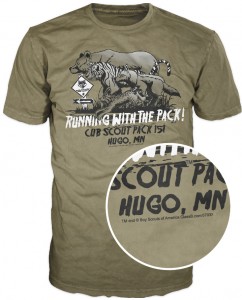
Basic designs are harder to hide the line, but as you can see, it does not stand out very much:
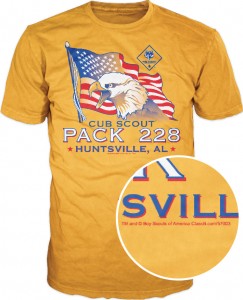
The only real problem is left crest or really small designs and licensing. There is just no place to hide it! Here is an example:
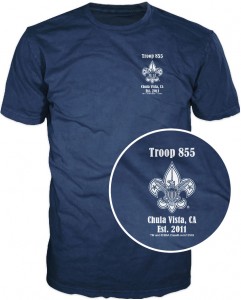
Some alternatives may be available. Please contact us to see if your order qualifies! Contact Us
Your design requires CPSIA information if the product is designed for or intended to be used by children under the age of 12. This basically means that any order that contains Adult medium or smaller shirts will include the CPSIA information. If you know that no children WILL use the product, the law reads that if a child COULD use the product, it requires the text. The CPSIA attribution line identifies the manufacturer and where to see the certificate of compliance.
Here is a link for more information about CPSIA: CPSIA 2008 Compliant – ECO-T
For licensing attributions, each license owner has specifications. Below are some example photos of our most common licensed properties:
An example of a Licensed product with CPSIA and licensing information:

Basic designs are harder to hide the line, but as you can see, it does not stand out very much:

The only real problem is left crest or really small designs and licensing. There is just no place to hide it! Here is an example:

Some alternatives may be available. Please contact us to see if your order qualifies! Contact Us
How does shipping work?
September 30, 2011
ClassB offers free shipping on all orders over $50.00 to any address using a 5-digit US Zip Code! In most cases, we will provide an in-hand date that you can count on.
We offer 3 levels of service for screen printed garments – Standard, Priority, and Rush, each with a different number of work days. See Rush Services for more information
All other decoration methods use Standard Service.
Standard Service is 12 business days from when you place the order until you receive the products to anywhere within the continental US using Fedex.
Priority Service is 9 business days from when you place the order until you receive the products to anywhere within the continental US using Fedex.
Rush Service is 6 business days from when you place the order until you receive the products to anywhere within the continental US using Fedex.
Just add 3 business days to any Service level if we are shipping to Alaska or Hawaii. See Shipping to Alaska and Hawaii. This applies to all addresses that can receive Fedex deliveries.
“International” Addresses (such as APO, FPO, DPO, and other territories of the US) will receive free Priority Mail Service on orders over $50.00. All products sent using US Mail will not have an in-hand date commitment but we will mail them to the US departure point using our regular production schedule.
Ink Color & Garment Color Interaction
September 29, 2011
The ink colors and garment colors are shown by themselves. If you are choosing a stock design and choose from our recommended colors, you should not need to worry about ink color & garment color interaction.
If you are picking your own colors, be aware of how different colors look when they are next to each other. Their are a few main areas to consider.
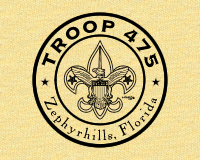
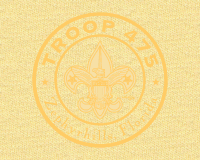
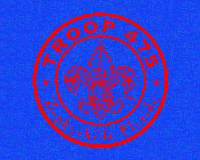
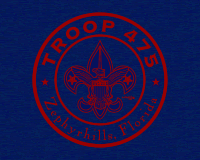

Contrast
If you would like your design to be readable from a long distance, choose a light shirt color and a dark ink color. If you select an ink and shirt color that are very similar, you will not be able to see the design at long distances. Low contrast designs are popular and some of our stock designs include low contrast options. High Contrast – – – – – – – – – – – – – – – – – – – – – Low Contrast

Saturation
Some colors do not go well together. They are too close in saturation and, when touching, create visually disturbing effects. Shifting to a darker shirt or ink color generally fixes this problem. Too Close Saturation – – – – – – – – – – – – – – Adjusted Colors

Opacity
Inks are not 100% solid. Any ink color will allow some of the shirt color to show through. In some cases, you may choose particular colors and, because of the ink being less than 100% solid, the ink and garment mix to a different color. Cyan Ink on Yellow Haze Shirts:
Online Garment Color Swatches
September 29, 2011
The color swatches shown on our web site represent our best effort to show you what color your shirts are going to be when you receive them. However, there are a number of factors influencing the accuracy of these swatches. Generally, you can trust the name of the color and be confident that your garments will be the color you expect them to be.
It’s also good to be aware of factors that affect fabric colors:
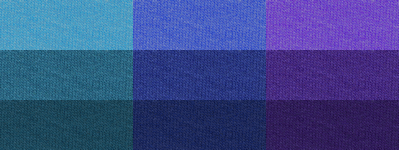 These shifts can make a Royal Blue fabric look purple, teal, navy blue, and lilac!
The best thing to do is calibrate your monitor using images that show colors that the human brain is best at distinguishing like skin tones and foods. Color calibration is typically done through the ” Monitor” or ” Display” Control Panel or Preference Panel.
These shifts can make a Royal Blue fabric look purple, teal, navy blue, and lilac!
The best thing to do is calibrate your monitor using images that show colors that the human brain is best at distinguishing like skin tones and foods. Color calibration is typically done through the ” Monitor” or ” Display” Control Panel or Preference Panel.
Dye Variation
Each “batch” of t-shirts are dyed with a hand-mixed dye. This means that the “red” shirts you order this year may be a slightly different shade of “red” than last year.Garment Care
Because each person will care for their garment in different ways, the shirts in your order may only match in color when they first come out of the box. Harsh detergents, hot water, and high heat dryers can all serve to fade a t-shirt prematurely. If you’re taking a group picture in your garments, take this picture before you send the shirts home with each person! You should also accept that your computer screen has different settings than our computers screen. For example, depending on your computer screen, some colors can seem like completely different colors! In the example below, the SAME color swatch has been shifted about 15% in hue and brightness in different combinations. These shifts can make a Royal Blue fabric look purple, teal, navy blue, and lilac!
The best thing to do is calibrate your monitor using images that show colors that the human brain is best at distinguishing like skin tones and foods. Color calibration is typically done through the ” Monitor” or ” Display” Control Panel or Preference Panel.
These shifts can make a Royal Blue fabric look purple, teal, navy blue, and lilac!
The best thing to do is calibrate your monitor using images that show colors that the human brain is best at distinguishing like skin tones and foods. Color calibration is typically done through the ” Monitor” or ” Display” Control Panel or Preference Panel.When can I view my art proof?
September 29, 2011
Once your order is placed, your design information will be sent to the art department where our talented group of artists will begin work on your design. Within 2 business days, an artist will post an artwork proof for your approval to our website. Once the art proof is available, your Customer Representative will email you a link to that page.
Your online art proof page is the place where you’ll be able to request any changes and give the final approval on your artwork before production. If you have trouble viewing your proof, give us a call at 1-800-851-4020 or email your Customer Representative.
Why does it take a so long?
For most of the year, we can turnaround stock designs with text and color changes in 1 business day. Complicated custom designs usually take longer, as they require more work from an artist to set up. During the busy season, we sometimes will need 3 business days to post complicated custom designs.
Your online art proof page is the place where you’ll be able to request any changes and give the final approval on your artwork before production. If you have trouble viewing your proof, give us a call at 1-800-851-4020 or email your Customer Representative.
Why does it take a so long?
For most of the year, we can turnaround stock designs with text and color changes in 1 business day. Complicated custom designs usually take longer, as they require more work from an artist to set up. During the busy season, we sometimes will need 3 business days to post complicated custom designs.
What’s the difference between Screen Print and Digital Print?
September 14, 2011
Screen Printing and Digital Printing are two different ways to apply a design to a garment. While there are a great many technical and process differences involved this is a basic overview.
We have a new page that covers the differences with detail here:
Decoration Methods Comparison
Screen printing is a stencil process that applies liquid ink to the garment, 1 color at a time. When cured, the ink is extremely durable and washes well. Screen printing has a lot of setup and clean up procedures so it is the best choice for larger orders of a few ink colors. Screen printing can be applied to a wide variety of garments, fabrics, and colors. Learn more.
Digital printing is an electronic printing process that is very similar to an ink jet printer. Once cured, the Digital print is durable but it requires more care in laundry and is not quite as durable as screen printing. Digital printing is much easier to process and is suited for short runs and images of high detail and multiple colors. The process is only available on 100% cotton fabric. Learn more.
We have a new page that covers the differences with detail here:
Decoration Methods Comparison
Screen printing is a stencil process that applies liquid ink to the garment, 1 color at a time. When cured, the ink is extremely durable and washes well. Screen printing has a lot of setup and clean up procedures so it is the best choice for larger orders of a few ink colors. Screen printing can be applied to a wide variety of garments, fabrics, and colors. Learn more.
Digital printing is an electronic printing process that is very similar to an ink jet printer. Once cured, the Digital print is durable but it requires more care in laundry and is not quite as durable as screen printing. Digital printing is much easier to process and is suited for short runs and images of high detail and multiple colors. The process is only available on 100% cotton fabric. Learn more.
